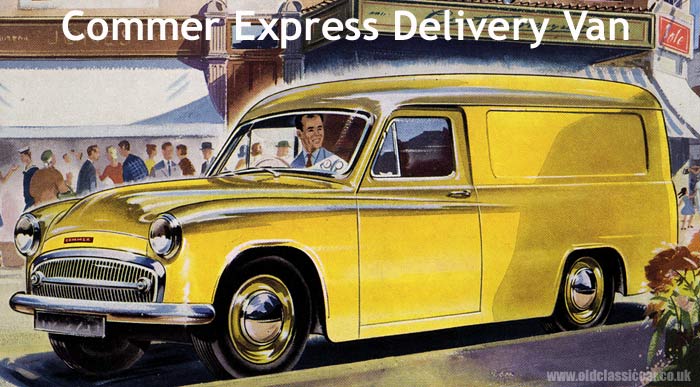
|
The Commer Express Delivery van.
Return to the Classic van & pickup section.
|

|
|
Commer had fielded small vans in the 8-10cwt range for many years, and in the late 1950s it was their Express Delivery Van that was offered to small-business owners and traders. Rivals of the day included the Ford Thames 300E and 400E vans, the Standard 7cwt van, Bedford's CA, and BMC's Minor and A55-based light commercials. The evolution of the Commer vans tended to mirror developments made to contemporary Hillman Minxes, another product of the Rootes empire. The specifications given here relate to the vans of late 1957, a model that would in later years and evolutions become the Cob.
|
|
Commer didn't quote a specific load rating for these vans, prefering to concentrate on the vehicle's roomy 100 cu ft loading space rather than the maximum weight it could carry. However any potential buyer in possession of basic maths skills, or a slide rule, could calculate that the maximum quoted gross vehicle weight of 28cwt, less the unloaded vehicle's weight of approximately 19cwt or so, left a payload weight of around 9cwt to play with. The vehicle measured some 13ft 4ins in length overall, with a width of 5ft 2ins and height of 5ft 6ins (unladen). The load-bay length was just under 5ft 9ins, with a maximum width of 4ft 10ins (3ft 2.75ins between the arches) available.
|
|
Powering the rear wheels of this smart van was a four cylinder Hillman engine of 1,390cc, which developed 47bhp at 4,400 rpm. A four speed column-change gearbox was fitted, with synchromesh on the top four speeds. Twelve volt electrics were standard, with twin electric windscreen wipers and flashing indicators meaning that the van's spec matched, or bettered, that of its rivals. A van driver more used to driving Ford's 10cwt offering for example, the E83W, which continued in production until 1957, could only dream of luxuries like this, having made do with six volts, vacuum wipers, three forward speeds and semaphore indicators, in true pre-war style. Jumping into a Commer Express Delivery would have been most welcome I'm sure.
|
|
Many of the Commer's benefits are highlighted in period literature from the late 1950s. Whereas vans such as the A35 and the Standard had a flat windscreen, the Commer had a curved "Opticurve" screen, another of its up-to-date features shared with contemporary Rootes Group saloons. Independent coil-sprung suspension ensured a decent ride comfort, as did the ".. comfortable driver and passenger seats of super quality - the former fully adjustable". If the owner preferred, he or she could instead opt for a bench seat. Twin rear doors offered easy access to the loading area, with the spare wheel hidden away beneath the floor. In addition to all the doors, the bonnet was also lockable, in a bid ".. to prevent pilferage".
|
|
By the late 1950s, monocoque construction was all the rage and most manufacturers were fielding cars and vans made in this way. While unitary construction seemed like the way forward, with improvements in both weight-saving and driving characteristics, the downside was that once rot had penetrated the structure, it wouldn't be long before the van became uneconomical to repair. Older vans, with separate chassis, could be patched up repeatedly yet still carry on working, as the sturdy chassis hidden away underneath was usually quite hard-wearing and tended to suffer maltreatment better than a unitary-bodied van. The Commer Express Delivery Van featured unitary construction, just as did rivals from Standard and most others (although BMC's Minor always had a separate chassis, as did Triumph's rarely-seen Courier van). Because of this, and a distinct lack of underbody rust prevention measures, they tended to rust away at quite an alarming rate if left unchecked. Those that survive today either led very sheltered lives, spent most of their days parked out of the weather, lived in foreign (warmer) climes, or else benefited from regular coatings of old engine oil to their undersides to ward off the onset of corrosion. The Commer van was probably no worse than similar offerings from other manufacturers, but this lack of rust prevention, allied to the hard life that most vans endure, mean that few survive today making them extremely scarce.
|
|
Commer vans were marketed in the UK and abroad, the scans below show a UK brochure from 1957, and also a slightly later version of the brochure designed for the French market.
|

|
|
More information on classic light commercials can be found in the van and pickup section.
|

|








